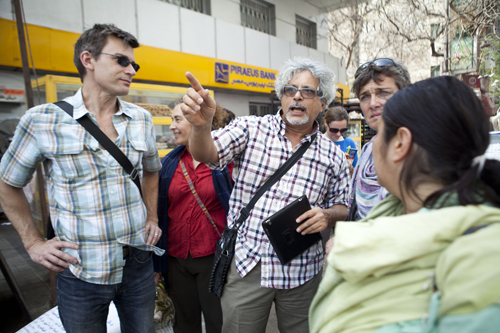
It’s 10 am Friday and Tahrir Square is quiet and empty. A bit further from the square, in downtown Cairo, a group of friends is gathering for their first coffee of the day, among them Nabil Shawkat, writer and organizer of leisurely Friday walks in Cairo.
“The story of these Friday walks comes from the book ‘A Walk Through the Islamic City’ by the Italian writer Jim Antoniou,” says Shawkat.
The book details the heart of historic Cairo with imagery so descriptive it feels like the reader is walking through Cairo’s streets. It describes different areas such as Mu’izz Eddin Allah, as well as Sultan Hassan Mosque and more than 90 other historic buildings.
Shawkat says he read the book five years ago and decided it would be a good idea to do the exact same walk described in the book. He asked some of his friends to join.
“I thought that after this, it would be over, but my friends kept calling me to organize more walks on Fridays,” he says. “Step by step, it became a habit to go on a walk every Friday. At the end, my friend Nicky used to organize them, until she left for overseas.”
Shawkat now organizes the meetings. After coffee, the walkers are ready to tour Cairo, walking from 10:30 am until 2 or 3 pm, depending on their availability.
The walkers are mainly expats looking for historic buildings, or hoping to have a relaxing time after a busy week at work.
Shawkat says members include journalists, writers, photographers, architects or NGO workers who appreciate history and arts.
The group mainly focuses on architecture from the 1930s and 1940s as well as some lesser-known architecture.
“These are not aimless walks. We are looking for history and architecture,” he says. “We try to find areas that are not touristic.
“As some of us are writers, there is also the possibility of finding inspirations for new stories,” Shawkat says.
The Friday walkers usually tour places such as downtown, Helwan, Shubra, Bulaq, Abdeen Palace, Ramhrah and Salteya, avoiding fancy tourist areas.
“Often, we go to places where the locals are not used to seeing foreigners, especially foreigners looking at their buildings. We are trying to find things that can’t be found in books,” Shawkat explains.
During the walk, participants share their knowledge about the places or their history. But most of the time, it’s Shawkat who answers questions in front of attentive and curious eyes.
It’s not obligatory to stay in the group and if one or two people want to stay longer in a place or talk to residents, he or she can join afterward — and anybody is free to observe and enjoy.
One of the participants, Francesca, is an architect from Germany. She came to Cairo last year to continue her studies at Ain Shams University.
Walking around with her map, she marks every street where a particular building interests her so that she can come back and spend more time at the place with her friends.
“I’ve wanted to join the group since I arrived in Cairo,” she says. “I knew of it through Nabil’s Facebook page.”
For her, the most fascinating Cairo architecture dates back to the Fatimid and Mohamed Ali eras.
“Usually, I’m more into contemporary architecture while people here are more interested in Islamic buildings. In any case, it’s always interesting, and I come every Friday, whether there is a party the night before or not,” Francesca says.
If Francesca comes every Friday, it’s also because it provides an opportunity to explore new neighborhoods. For Parastou, an Iranian woman who works in refugee law in Cairo, the walks are the best way to get to know the city.
“I’m less interested in architecture than the others, but I like to meet local people, get new connections, and it’s a nice way to remember the good things about Cairo,” she says.
In case walkers can’t join, they can follow Shawkat’s posts from an app he added on his iPad. During each four-hour walk, Shawkat takes pictures with his iPad to share on Every Trail, a platform on which people can share their travels and experiences around the world.
Later, he adds the descriptions and history of the places and buildings they visited. It’s also possible to see the whole track on a map, in case people want to do the walk by themselves.
As Shawkat and others take pictures, they sometimes face problems with residents.
“Sometimes we want to take pictures of a building but there is garbage in front of it. So locals complain that we are taking pictures of the garbage and trying to portray a bad image of the area,” he says.
He adds that sometimes people pay them too much attention because the group contains many foreigners, or make fun because they think they’re tourists.
“Sometimes, locals tell me to go to ‘greater places’ such as Al-Azhar,” Shawkat says with a smirk.
This past Friday, the “walking elite,” as Shawkat calls the group, explored the Sayeda Zeinab area up to Helwan Street, taking in the narrrow streets studded with hidden historic buildings and architecture from the early and mid-19th century.
They stopped once for a drink before continuing their trp and walked for the full four hours, despite rather high temperatures.
“I have no idea where we are going but that’s good for me, as it’s the only day of the week when I don’t have to make any decisions and that feels good,” says Nancy, an American working for UNICEF who’s been taking part in the Friday trips for the past five years. “It’s absolutely relaxing and we meet friendly people and it’s the only day I can socialize. It’s also an opportunity to see Egypt, as I don’t really see it anymore.”
The walks take place all year except for July and August, when the temperatures are too high.
“They are the only two months where there aren’t any walks. Also, we cancel if the coffee shop where we meet is closed. That’s very important to us,” Shawkat says with his characteristic smile.
This piece was originally published in Egypt Independent's weekly print edition.




